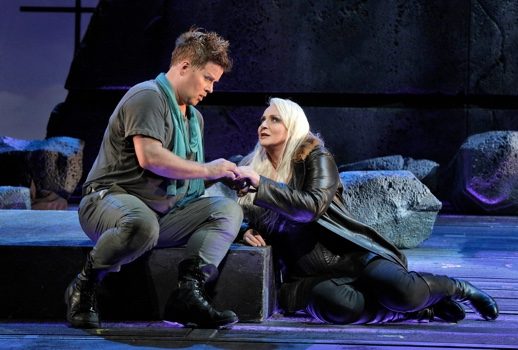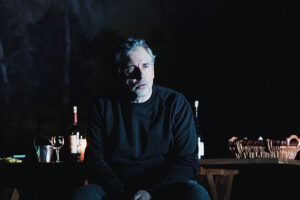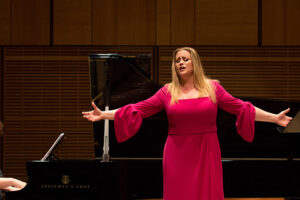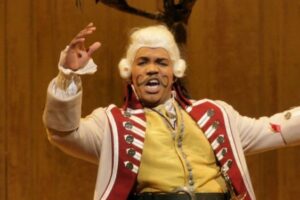

Sleep no more: Daniel Brenna and Iréne Theorin.
Siegfried is, in a sense, The Ring’s odd one out. It’s the most intimate opera in the cycle, calling for an eighght-person cast and no ensemble. In mood it’s also the lightest, offering significant periods of genuine comic relief and good humor. But all of this lightness ought not distract us from the tectonic shift occurring beneath the surface: a shift from a world centered around gods, dwarves, and giants to a world of men.
The guardians of the old order gradually cede power and slip into irrelevance. The once proud Wotan roams the world in human form. And the human virtues – fear and love (a virtue which, when last we saw it, killed Wotan’s son and his wife and stripped Brünnhilde of her divinity) now point the way to rebirth.
And just as the world of The Ring could never be the same after these shifts, likewise the course of German romantic music tradition was abidingly altered after the composition of Siegfried. There are few passages in the operatic repertoire more fulfilling for orchestral musicians to play than its last scene:the final, blissful union of musical ideas and human beings, into an inevitable whole.
And though the first two acts of Siegfried may not have the “Gesamtkunstwerk factor” of the opera’s conclusion, the brilliance of their orchestral writing also left an indelible imprint on the repertory.
Act 1 is almost unparalleled in its maintenance of an agitato texture over time. Over the course of more than an hour, Wagner uses a tapestry of interlocking motives to stretch his musical game of cat and mouse between Mime and Siegfried almost interminably, finally reaching its climax—when we can hardly bear any more —in the re-forging of Siegfried’s sword.
Rarely do music lovers consider how difficult it is to write a compelling agitato—to marry motion with an ever-mounting sense of harmonic tension, maintaining a sense of direction without any end in sight. Wagner’s example here, building on the heritage of Beethoven, Berlioz, and particularly Weber, is a masterwork of romantic period orchestration, an hour-long orchestral fire hot enough to melt steel.
Act 2’s consequences for romantic music were, if anything, more profound. In the “Forest Murmurs” music, Wagner (again building on Weber and the lieder of Schubert) created a new orchestral language that combined the pastoral topos with the inward soul-searching of the German wanderer.
The result was a more muted and contemplative pastoral music, where the gentle undulations of mid and low-range clarinets and horns serve less as a backdrop for contemplation than as a mirror for the wanderer’s own thoughts. There is something in the orchestration of the scene that gets us to wonder right away, when the Forest Bird appears to counsel Siegfried, whether her song is simply another voice within his own mind.
That inward interpretation of the pastoral scene, which owed its literary inspiration in such writers as Goethe and Wordsworth, found its earliest musical expression in Schubert’s Der Lindenbaum, the Oberon and Der Freischütz overtures of Weber and, perhaps more than any other work, this scene.
Clearly aware of the great opportunity this music affords its performers, Donald Runnicles’ orchestra at the SF Opera was exceptional throughout. The “Forest Murmurs” scene was lovingly performed, with a wide palate of dark colors in the brass, clarinets, and bassoons, vanishingly soft pianos,and effortless bird calls in the high woodwinds, including some beautifully light flute flutter-tonguing.
In the Act 3 scene of Brünnhilde’s awakening, Runnicles achieved a truly edge-of-seat accompaniment as our heroine stirred and sat up for the first time, passing portentous low-voiced minor chords in the brass to the woodwinds, connected with airy figurations in the strings and improvisatory arpeggiations in the harp. Wagner’s introduction of the Siegfried Idyll music in the strings was hushed but spacious.
While there were certain moments of subpar wind intonation and string sectional imprecision, they were infrequent. (I refer particularly to the moments in the final scene in which Wagner pares the orchestration down to a melody line in a single string section. The blurry chiaroscuro effect created by sloppy listening within the section defeats Wagner’s intimate purposes in this music.)
Balance between stage and pit was a significant issue in Siegfried, but one can’t blame Runnicles’ orchestra for that. There are limits to how much a Wagnerian orchestra can adjust to accommodate a small-voiced lead. Unfortunately in Daniel Brenna as Siegfried, that was exactly what they got.
Brenna showed an impressive expressive range and excellent acting abilities—evolving from the childlike (and often gratuitously abusive) ward of Mime into a fearless warrior and then fearful lover. But he struggled with his role’s fundamental challenge: projecting over the orchestra.
This struggle was particularly apparent amid the hyperactive orchestral textures of Act 1. Likewise in his final duet with Brünnhilde, he seemed overmatched by her power in the high register. Francesca Zambello’s staging, which often had Brenna running around, singing upstage and at oblique angles, certainly did not help. But in comparison to, say, Brandon Jovanovich as Siegmund, Brenna did not come close to establishing the same presence.
Brenna’s acting, however, was youthful and frequently hilarious. From his affected middle-schooler’s slumped walk into Fafner’s den, sword swinging like a book bag on his back, to his eye rolls of exasperation every time Brünnhilde eluded his grasp to prattle on about her lost divinity, Brenna showed a buoyant energy that rubbed off on everyone else on stage. He also demonstrated an unusual gift at miming horn playing!
Every bit Brenna’s equal as an actor and slightly (though only slightly) more penetrating as a singer was David Cangelosi in the role of Mime, Siegfried’s selfish caretaker. Residing in a trailer park, Cangelosi embraced his Wile E. Coyote character with enthusiasm and good humor.
Wagner frequently dramatizes Mime’s wretchedness by accompanying him discreetly, and Cangelosi took full advantage, providing an intense but soft sound which made the dramatic irony of his whispered confessions to the audience fully believable. He even showed a sensitive, lyrical side in the few moments Wagner allowed it.
Cangelosi’s only real blemish was a couple noticeable slips in declamation, where he seemed to emphasize less important ideas or words at the expense of more essential ones—perhaps most noticeably where he dropped the biggest bomb of the first act, “I am not your real father,” with all the gravitas of a server reciting the night’s specials.
For Iréne Theorin as Brünnhilde, her 20 minutes of fame in Siegfried showed her to have an expressive gear that we did not see in Die Walküre. In a scene which requires her to contend with large orchestral swells, she positioned her voice easily on top, shaping long phrases and employing an intuitive rubato which put her on the same page with Runnicles’ pit almost without having to look.
There were momentary imperfections —the sotto voce she used against the minor repetition of the Siegfried Idyll melody in the strings was slightly too soft, a couple of her upward leaps a touch too strident. But overall, she showed a level of organic musical intuition that puts her in select company in this cycle.
In Siegfried, nowhere is the impending “twilight of the gods” more clearly foreshadowed than in Wotan’s characterization as a Wanderer. A once omnipotent god finds himself forced into that most pitifully human role in German romantic poetry: the scorned lover who roams the world in a futile search for comfort. (This is, at least, the immediate association Wagner’s contemporaries would have had with such a figure.)
And as with any good wanderer, the purpose of Wotan’s wanderings becomes increasingly blurred. A mounting contradiction – that helping Siegfried recover the gold will simultaneously redeem a fallen world and cause his own demise – puts him into a state of near paralysis. By his meeting with Siegfried in Act 3, we all know that the jig is up.
There was something about the character of the Wanderer that brought out the best of Greer Grimsley’s Wotan – an expressiveness and sense of humor that had been stifled by his country club persona in the first two operas.
The opportunity he had in Siegfried to roam the stage in torn vestments, to share a pre-test-of-wits cold one with Mime, or to petrify Alberich by waking Fafner’s dragon, gave him an extra shot of musical adrenaline, revealing a far more compelling stage actor than we had seen thus far. Musically, Grimsley’s tone made up in pathos anything that it lost in confidence as Wotan spiraled toward his demise.
Erda, of course, undergoes a similar fate. After her single brief appearance in Das Rheingold, any Ring audience remembers Erda as a pillar of stability in a fallen world—a voice almost never heard but comfortingly close by. In her second and final appearance last night, contralto Ronnita Miller arrived with the poise and gravity we remembered.
But as soon as Wotan informed her that he had shunned their daughter Brünnhilde, dashing Erda’s only hope for a return to the status quo ante, all stability seemed to flow out of her. As she sang the words “the world seems so wild and confused,” her sonorous low range took on a tenor of ominous doubt.
In the role of Alberich, Falk Struckmann brought back his thunderous, snarling bass-baritone, evincing no sign of the emasculated Alberich we remembered from the close of Das Rheingold. Raymond Aceto as Fafner, slain at the hands of Siegfried, finally got the chance to show his softer side as he lay dying, allowing a brief glimpse of a more lyrical bass sound. And Stacey Tappan deserves mention for a perfectly lovely Forest Bird, engaging as a mute pantomime and warm in her tone.
Zambello took seriously the opportunity to do something different in Siegfried. Given a somewhat weaker vocal cast, She was able to take some of the pressure off by focusing on acting.
The first act, set in a trailer park piled with garbage, had a deeply black comic feel. Brenna’s Siegfried and Cangelosi’s Mime chased each other around the stage in a directionless, almost nihilistic pursuit. Zambello’s staging of Act 2 was odd in one important—and not a little ridiculous seeming—respect: her decision to cast Fafner’s dragon as a Transformer.
As Siegfried swung his sword at its exterior, rather than drawing blood, he drew showers of sparks and electrical smoke before Fafner, shirt somehow bloodied, tumbled out of his ‘dragon.’
But any memory of Siegfried’s strange victory over the Transformer was quickly banished from our minds as Siegfried approached the sleeping Brünnhilde – a moment poignant enough that it needed no directorial embellishment. With one irreversible act of human love, the twilight of the gods had begun.























Comments